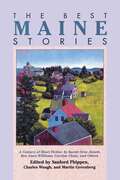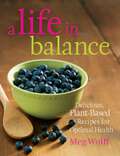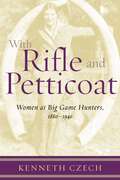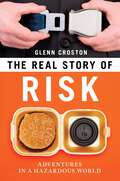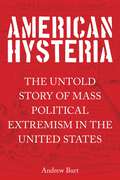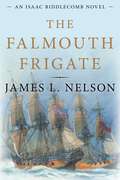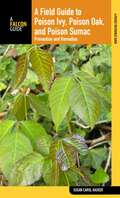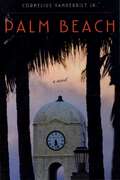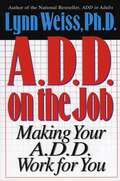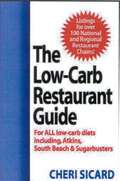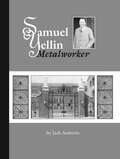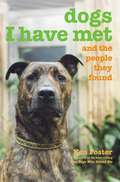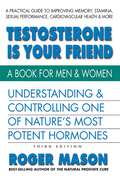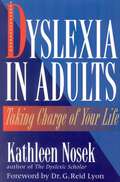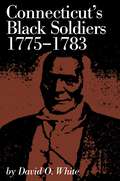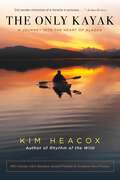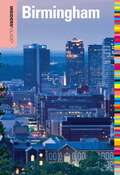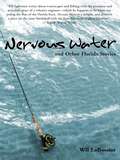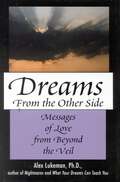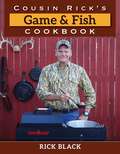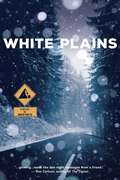- Table View
- List View
The Denver Broncos All-Time All-Stars: The Best Players at Each Position for the Orange and Blue (All-Time All-Stars)
by Mike KlisLet&’s say you&’re the head coach of the Denver Broncos, deciding which players should start in a Super Bowl matchup against the toughest team in the NFC. But instead of choosing from the current roster, you have every player in the team&’s nearly sixty-year history in your locker room. Who starts at quarterback: John Elway, Peyton Manning, Craig Morton, or Frank Tripuka? At inside linebacker, do you play Bill Rowmanowski, Karl Mecklenburg, Tom Jackson, Randy or Gradishar? Which player is your featured running back: Floyd Little, Otis Armstrong, or Terrell Davis? Combining career stats, common sense, and a host of intangibles, veteran Broncos beat reporter Mike Klis imagines an embarrassment of riches and sets the all-time All-Star Broncos lineup for the ages.
The Best Maine Stories
by Sanford PhippenSet in an enchanting, mysterious, and sometimes very hard state, the selections in Best Maine Stories speak profoundly to the rest of America of a unique land of the heart.
A Life in Balance: Delicious Plant-Based Recipes For Optimal Health
by Meg WolffThe first title in Down East Books' 'Best Maine Food' series, this inspirational cookbook proves that good food fosters good health. When conventional medical treatments couldn't stop Meg Wolff's breast cancer in 1998, doctors told her to prepare her soul. Instead, she began a diet based on whole grains, vegetables and beans - and started getting better. Now vibrantly healthy, Meg is living proof that changing your diet can indeed save your life. This cookbook is full of Meg's easy, delicious recipes and information to help inspire readers to eat better, and live better. Contains recipes from a variety of contributors including NBA great John Salley and Dr. Neal Barnard, head of the Physicians for Responsible Medicine.
With Rifle & Petticoat: Women as Big Game Hunters, 1880-1940
by Kenneth CzechThe image that comes to mind when you think of big game hunters is of African safaris with men carrying enormous guns hunting exotic game. But there were women on those trips as well, and not just the trips to Africa, and they were often as successful at the hunt as the men. Women such as Lady Florence Dixie, Agnes Herbert, Osa Johnson, Grace Gallatin Seton, and Gladys Harriman hunted so well, they made names for themselves and wrote of their adventures. Divided into chapters detailing a specific time period, region hunted or individual woman, With Rifle and Petticoat explores the interesting women who hunted a variety of big game animals around the world.
Real Story of Risk: Adventures in a Hazardous World
by Glenn CrostonWe live in a world of risk. It waits for us in our refrigerator and surrounds us on the freeway. It's lurking in our arteries and sitting in our 401(k) accounts. Given that we deal with risk on a constant basis, we should be good at it; as it turns out, though, we're not. We're blind to common risks like heart disease (one in five deaths), but we shrink in fear from rare events like shark attacks (one in a million) and airplane crashes (one in twenty thousand). What accounts for our poor ability to perceive and react to the risks that really matter? Starting from an evolutionary perspective, the author traces our distorted perception of risk back to our ancestors, reminding readers that we are all the culmination of a long line of survivors who fought life-and-death threats such as attacks from wild animals, starvation, and disease. The fact that we have covered Earth with seven billion people is a testament to our skill at overcoming these risks. But our spectacular success has also produced our contemporary artificial world with new threats like climate change, chili dogs, and online gambling. Our brains, which evolved to deal with the ancient world, are ill equipped to process the new threats we face. Croston examines the many facets of our hazardous modern environment that we only dimly perceive. He explains why we let our guard down for a beautiful face, why slow-moving risks (like rising seas) are hard to stop, how a good story (though false) can be more persuasive than dry statistics (even alarming ones), what we fear even more than death, and many other intriguing quirks about our built-in incompetence to adequately handle present-day risks. Offering a wealth of fascinating information about health, sex, money, safety, food, and the environment, this book illuminates an often-misunderstood but crucial aspect of daily life.
American Hysteria: The Untold Story of Mass Political Extremism in the United States
by Andrew BurtThis debut book from Andrew Burt details the pivotal moments in American political history when outliers moved to the center, capturing the national spotlight and turning fringe politics mainstream. American Hysteria puts readers at the center of the nation&’s most prominent periods of political extremism, from the Anti-Illuminati movement of the 1790s to McCarthyism in the 1950s to the Anti-Sharia movement of today. Both a deep dive into American history and a riveting narrative account, this is book is as much history lesson as it is drama.Burt argues that political hysteria arises in periods of deep uncertainty about American identity, and that when Americans lose their sense of who they are, they lash out against perceived threats with blacklists, scapegoating, conspiracies, cover-ups and more. By exploring the infamous and sometimes forgotten movements and characters of our nation&’s past, this fascinating book provides a unique view into America&’s history, its identity, and ultimately its future.
Falmouth Frigate: An Isaac Biddlecomb Novel (Isaac Biddlecomb Novels)
by James L. NelsonThe year 1777 is bleak indeed for the cause of American Independence, with the British army twice defeating Washington and taking the capital city of Philadelphia and the Royal Navy sweeping aside the defenses of the Delaware Bay.And for Captain Isaac Biddlecomb and the men of the half-built frigate Falmouth, things are direr still. After managing to slip through a British blockade, they find themselves trapped in a desolate harbor on the New Jersey coast and menaced not by the British but by the outlaw bands that terrorize the countryside and see Falmouth as a potentially valuable prize. Deserter Angus McGinty steals Biddlecomb&’s most potent weapon, the captured British sloop Sparrowhawk, leaving him to face the ruthless Pine Robbers on his own, with only his diminished crew and the near-useless local militia to help.Meanwhile, Virginia Biddlecomb, trapped in occupied Philadelphia, sees her chance to play a clandestine role in the fight. In the course of her activities, however, she lets slip information that will put her husband, his ship, and his crew in mortal danger, leading to a desperate race to get the unwieldy Falmouth to a place beyond the reach of the Royal Navy.
Field Guide to Poison Ivy, Poison Oak, and Poison Sumac: Prevention And Remedies
by Susan Carol HauserThis handbook takes the mystery out of identifying these common weeds and provides useful antidotes for treating their irritating, itching rashes. Photos show the plants in every season, and detailed drawings help readers pinpoint the culprit in the woods or in their own backyards. Hauser distinguishes between home remedies that really work and those that can actually aggravate the poison, tells how to treat each poison differently, and explains how to prevent the offending vines from growing in the yard. The perfect reference for homeowners, parents, gardeners and hikers, this is easy to read and informative. Susan Carol Hauser is a writer and gardener who lives in Bemidji, Minnesota.
Palm Beach: A Novel
by Cornelius VanderbiltMarjorie Duke has waited her whole life for the whirlwind of her debut: shopping in Paris, attending fashionable balls, and meeting the Who's Who of Palm Beach before finally falling in love. Chaperoned by her ailing mother, Marjorie comes to the jarring realization that her mother, to whom she has looked for guidance her whole life, has no better sense of the social landscape and pitfalls of coming out than Marjorie herself.Relying on her natural charm and beauty, Marjorie soon snares the attention of Allie, an eligible handsome British nobleman who squires her to the beach by day and to balls by night. Through the whirlwind of courtship, she has only the keen-eyed newspaperman Goose to confide in. Marjorie is designing her destiny, but she has yet to determine the shape of love and happiness.
Our Favorite Noodle & Rice Recipes: A bag of noodles, a box of rice?we've got over 60 tasty, thrifty ways to fix them!
by Gooseberry PatchA bag of noodles, a box of rice…we've got over 60 tasty, thrifty ways to fix them! Warm up with a bowl of cheesy wild rice soup and round out a meal with rice pilaf or farmhouse egg noodles. Purse-friendly size cookbooks makes meal-planning on the go easy.
A.D.D. on the Job: Making Your A.D.D. Work for You
by Lynn Weiss PhDHere is practical, sensitive advice for the employee, boss, coworkers, and friends. A.D.D. on the Job suggests advantages that the A.D.D. worker possesses, how to find the right job, and how to keep it. Employers and coworkers will learn what to expect from a fellow worker with A.D.D. and the most effective ways to work with them.
The Low-Carb Restaurant: Eat Well at America's Favorite Restaurants and Stay on Your Diet
by Cheri SicardIn the past, dieting and dining out have not gone well together, but now all that has changed. This easy to follow guide provides low-carb information on over 100 national restaurant chains, making it a simple diet, even when eating away from home.
Samuel Yellin: Metalworker
by Jack AndrewsSamuel Yellin, Metalworker is a photographic essay and documentation about the master artist-blacksmith Samuel Yellin representing the culmination of 19th-century wrought iron design and fabrication. This book is the only attempt to record carefully the evolution of this artistic giant. In Philadelphia, from 1909 to 1940, Yellin created wrought iron work for major clients and architects throughout the US. There are the historic photos of Yellin and those who worked in this famous shop. Better are the many pages of his wrought iron, each piece speaking volumes. There are gates, railings, keys, locks, fireplace sets, lighting devices, and whimsical creatures. The scale of this work is sometimes overwhelming. There is a complete list of Yellin's works recorded on job cards. These cards will help researchers in locating samples of this incredible work. Samuel Yellin's masterpieces remain an important subject to examine, not only for blacksmiths but also for artists, architects, interior designers, historians, and anyone who works with or enjoys metalwork.
Dogs I Have Met: And the People They Found
by Ken FosterKen Foster knows that a dog can change a person&’s life. And that several dogs can change even more. For THE DOGS WHO FOUND ME, the author appeared in major media interviews such as NPR&’s &“Fresh Air&” with Terry Gross, and received hundreds of letters and stories about other karmic canine rescues. Many of these heartwarming stories are now compiled in this all-new follow-up to the original bestseller. DOGS I HAVE MET introduces us to injured California pit bull Jimmy, among others, as well as to one woman who opened her house to 55 stray dogs. Ken Foster will once again travel the country for interviews and in-store events to promote dog rescue and this all-new national bestseller.
Testosterone Is Your Friend
by Roger MasonAlthough testosterone is considered a male sex hormone, what many people don&’t realize is that this vital hormone is also present in females. For men, it is mainly responsible for stimulating and controlling characteristics that are considered &“masculine,&” like muscles and hair growth. However for both sexes, low testosterone levels can cause countless health problems including memory loss, anxiety and depression, osteoporosis, increased cholesterol levels, weight gain, sexual dysfunction, and infertility. While testosterone supplements are available, most are ineffective and some are even dangerous.In the updated third edition of Testosterone Is Your Friend, author Roger Mason presents the latest and most effective natural treatments and supplements to help raise testosterone levels. The book begins by looking at how the body uses testosteroneand how this hormone functions differently in men and women. Later chapters examine how testosterone deficiency affects various health conditions. In addition to presenting safe treatments for elevating testosterone levels naturally, the author also explains how simple it is to test the levels yourself. It&’s time to re-energize. With Testosterone Is Your Friend, you will have the latest information on how to increase your testosterone levels safely and naturally. By following the advice within, you can improve not only your sex life, but also the overall quality of your life.
Dyslexia in Adults: Taking Charge of Your Life
by Kathleen NosekAuthor Kathleen Nosek offers dyslexic adults a unique approach that gets to the heart of the biggest problem they face—the shame and battered self-esteem resulting from decades of struggling with this frustrating and often misunderstood learning disability.
Connecticut's Black Soldiers, 1775-1783
by David O. WhiteBlack soldiers of the American Revolution? Not a credible statement in light of what most Americans have read about the Revolutionary War. We have heard of Casimir Pulaski the Pole, Marquis de Lafayette the Frenchman, and Baron von Steuben the German, but not black participants. Yet, close to 5,000 blacks did fight in the war against the British, and others served as laborers, spies, and guides. The absence in our general histories of their activities in this struggle lies with the misconception that the Afro-American has contributed little or nothing towards the creation of the United States and its subsequent development, for in most studies made of the Revolutionary era, there has been little impulse to search for evidences of service by blacks, except perhaps to note the existence of slavery. Histories of Connecticut have generally treated the Revolution in a similar manner. Few of them have acknowledged the contributions of the black soldier. This is partially true because the story of Connecticut's black participant is one about the regular foot soldier in the Revolution and not about the men who led him into battle or the political leaders who guided the nation. And it is these men who most often fill the pages of our history books. As one phase of the Bicentennial observation, The American Revolution Bicentennial Commission of Connecticut has authorized scholars in a wide range of study to write a series of monographs on the broadly defined Revolutionary Era of 1763 to 1787. These monographs [appeared] yearly beginning in 1973 through 1980. Emphasis is placed upon the birth of the nation, rather than on the winning of independence on the field of battle.
Only Kayak: A Journey Into The Heart Of Alaska
by Kim HeacoxWinner of the 2020 National Outdoor Book Award for Outdoor Classic!In this coming-of-middle-age memoir, Kim Heacox, writing in the tradition of Abbey, McPhee, and Thoreau, discovers an Alaska reborn from beneath a massive glacier, where flowers emerge from boulders, moose swim fjords, and bears cross crevasses with Homeric resolve. In such a place Heacox finds that people are reborn too, and their lives begin anew with incredible journeys, epiphanies, and successes. All in an America free of crass commercialism and overdevelopment.Braided through the larger story are tales of gold prospectors and the cabin they built sixty years ago; John Muir and his intrepid terrier, Stickeen; and a dynamic geology professor who teaches earth science "as if every day were a geological epoch."Nearly two million people come to Alaska every summer, some on large cruise ships, some in single kayaks--all in search of the last great wilderness, the Africa of America. It is exactly the America Heacox finds in this story of paradox, love, and loss.
Insiders' Guide® to Birmingham (Insiders' Guide Series)
by Todd KeithYour Travel Destination. Your Home. Your Home-To-Be.BirminghamFestivals. Architectural gems. Green spaces. Friendly faces. The Magic City. A special kind of place. • A personal, practical perspective for travelers and residents alike• Comprehensive listings of attractions, restaurants, and accommodations• How to live & thrive in the area—from recreation to relocation• Countless details on shopping, arts & entertainment, and children&’s activities
Nervous Water and Other Florida Stories
by Wil LabossierNervous Water and Other Florida Stories is a collection of six short stories that explore the spirit of fly-fishing today. The author uses tales of stalking fish in Florida to examine environmentalism, philosophy, fishing as entertainment, the nature of celebrity, the meaning of relationships, and the importance of fishing to our identities. Nervous water can tell you where the fish are moving just beneath the surface, but it also implies that just under the surface lies an uneasiness, an apprehension about the future, and that within this anxiety lives the possibility—maybe even the promise—of something better.
Dreams from the Other Side: Messages of Love from Beyond the Veil
by Alex LukemanThe stories in this book are all true. Many are dreams of loved ones who returned to the dreamer days, months, or even years after death. Alex Lukeman stresses the fact that while some dreams of the departed are psychological in nature, there are also such things as true dreams of return. In these, a sense of completion and deep connection is always present.
Cousin Rick's Game and Fish Cookbook
by Rick BlackGood ol boy, Cousin Rick Black, is passionate about hunting, fishing, and cooking wild game and fish, and he&’s spent a lifetime collecting and testing recipes for every kind of fish, fowl, and game, both large and small. Now he shares 250 of his favorite recipes for deer, elk, antelope, caribou, moose, bear, buffalo, squirrel, rabbit, beaver, raccoon, trout, bass, salmon, and panfish. In addition to the recipes, Rick includes chapters on rubs and marinades, cooking with beer, and how to cook for wild game banquets. Great tasting wild game starts with savvy field dressing, and Rick shares plenty of tips and helpful info on how to best and safely prepare game and fish before you get to the kitchen. And Rick knows that cooking game should be a rewarding and enjoyable experience so, in typical Cousin Rick style, he includes a dollop of down-home humor too.
Rhode Island Off the Beaten Path®: A Guide to Unique Places (Off the Beaten Path Series)
by Robert CurleyTired of the same old tourist traps? Whether you&’re a visitor or a local looking for something different, let Rhode Island Off the Beaten Path show you the Ocean State you never knew existed. Give your eyes a feast at one of the state&’s best-kept secrets, the Culinary Archives and Museum in Providence; take in a ball game and soak up the old-time atmosphere at charming Cardines Field in Newport; or stroll through Charlestown&’s Fantastic Umbrella Factory shops, a funky collection of 1960s-style boutiques. So if you&’ve &“been there, done that&” one too many times, get off the main road and venture Off the Beaten Path.
White Plains: A Novel
by David HicksFlynn Hawkins is a graduate assistant at a prestigious university, on his way to greatness and wisdom. But in the aftermath of 9/11, Flynn leaves his unhappy marriage and beloved children, resigns his teaching position and heads west, only to get lost in his guilt and in the mountains of Colorado. When he ends up stuck overnight in a snow drift during a blizzard on the Continental Divide, he realizes he needs to remake himself into the kind of man his children need him to be. With wit and insight, David Hicks turns a compassionate but unblinking eye on what it means to be human—to be lost while putting yourself back together again, to be cowardly while being brave, to fail and fail again on the way to something that might be success.
It Happened in Washington: Remarkable Events that Shaped History (It Happened in the West)
by James A. CrutchfieldIn It Happened in Washington you'll sail the seas along Washington's rugged coast, explore the untamed wilderness of the U.S.-Canada border, and climb to the summit of Mount Rainier. This collection includes thirty-three extraordinary episodes from Evergreen State history.

